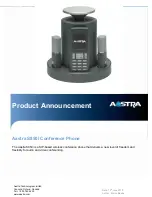
3-10
Cisco Security Appliance Command Line Configuration Guide
OL-12172-03
Chapter 3 Enabling Multiple Context Mode
Enabling or Disabling Multiple Context Mode
username “admin.” The admin context does not have any command authorization configuration, but all
other contexts include command authorization. For convenience, each context configuration includes a
user “admin” with maximum privileges. When you change from the admin context to context A, your
username is altered, so you must log in again as “admin” by entering the
login
command. When you
change to context B, you must again enter the
login
command to log in as “admin.”
The system execution space does not support any AAA commands, but you can configure its own enable
password, as well as usernames in the local database to provide individual logins.
Context Administrator Access
You can access a context using Telnet, SSH, or ASDM. If you log in to a non-admin context, you can
only access the configuration for that context. You can provide individual logins to the context. See See
Chapter 40, “Managing System Access,”
to enable Telnet, SSH, and SDM access and to configure
management authentication.
Enabling or Disabling Multiple Context Mode
Your security appliance might already be configured for multiple security contexts depending on how
you ordered it from Cisco. If you are upgrading, however, you might need to convert from single mode
to multiple mode by following the procedures in this section. ASDM does not support changing modes,
so you need to change modes using the CLI.
This section includes the following topics:
•
Backing Up the Single Mode Configuration, page 3-10
•
Enabling Multiple Context Mode, page 3-10
•
Restoring Single Context Mode, page 3-11
Backing Up the Single Mode Configuration
When you convert from single mode to multiple mode, the security appliance converts the running
configuration into two files. The original startup configuration is not saved, so if it differs from the
running configuration, you should back it up before proceeding.
Enabling Multiple Context Mode
The context mode (single or multiple) is not stored in the configuration file, even though it does endure
reboots. If you need to copy your configuration to another device, set the mode on the new device to
match using the
mode
command.
When you convert from single mode to multiple mode, the security appliance converts the running
configuration into two files: a new startup configuration that comprises the system configuration, and
admin.cfg that comprises the admin context (in the root directory of the internal Flash memory). The
original running configuration is saved as old_running.cfg (in the root directory of the internal Flash
memory). The original startup configuration is not saved. The security appliance automatically adds an
entry for the admin context to the system configuration with the name “admin.”
To enable multiple mode, enter the following command:
hostname(config)#
mode multiple
Содержание 500 Series
Страница 38: ...Contents xxxviii Cisco Security Appliance Command Line Configuration Guide OL 12172 03 ...
Страница 45: ...P A R T 1 Getting Started and General Information ...
Страница 46: ......
Страница 277: ...P A R T 2 Configuring the Firewall ...
Страница 278: ......
Страница 354: ...17 38 Cisco Security Appliance Command Line Configuration Guide OL 12172 03 Chapter 17 Configuring NAT NAT Examples ...
Страница 561: ...P A R T 3 Configuring VPN ...
Страница 562: ......
Страница 891: ...P A R T 4 System Administration ...
Страница 892: ......
Страница 975: ...P A R T 5 Reference ...
Страница 976: ......
















































